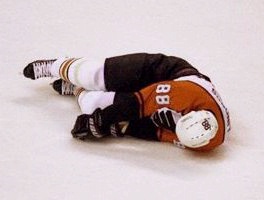 History and Presenting Symptoms
History and Presenting Symptoms
The patient is a 26-year-old male amateur hockey player, who reports a recent left hamstring “pull” that just doesn’t seem to be getting better. His history includes numerous injuries to the same hamstring muscle when he played in college, with mixed attempts to stretch and rehab. He also describes varying levels of pain in his lower back and right hip region, and requests a comprehensive musculoskeletal evaluation.
Exam Findings
Vitals. This athletic young male weighs 166 lbs, which, at 5’10’’, results in a BMI of 24; he is not overweight. He is a non-smoker, and his blood pressure and pulse rate are at the lower end of the normal range.
Posture and gait. Standing postural evaluation finds generally good alignment, with intact spinal curves, but a slightly lower iliac crest on the left, along with a lower left greater trochanter. His spine appears to be well-balanced above, with no evidence of lateral curve or list. He also demonstrates left calcaneal eversion and a low medial arch (hyperpronation). A tendency to toe out on the left is seen during gait screening, and he confirms that he needs to be conscious of his left foot position when skating.
Chiropractic evaluation. Motion palpation identifies a mild limitation in right sacroiliac motion, with moderate tenderness and loss of end range mobility. Compensatory subluxations are identified at L4/5 and L2/3. Otherwise, all orthopedic and neurological testing is negative.
Primary complaint. Examination of his left lower extremity finds tenderness to palpation at the ischial insertion and in the medial belly of the hamstring muscle group. Straight leg raise is limited to 60° by hamstring tightness and pain, and active knee extension is restricted when the hip is placed in 90° of flexion. Manual muscle testing finds painful weakness in the left hamstring, when only moderate resistance is provided.
Imaging
Because of his history of recurrent strains and the evidence for postural asymmetry, an upright lumbopelvic series was obtained. The standing AP lumbopelvic view shows a lateral pelvic tilt, a low sacral base on the left, and the left femur head is 5 mm lower.
Clinical Impression
Hamstring muscle injury is associated with chronic biomechanical strain. A functional short leg on the left is accompanied by sacroiliac joint motion restriction and compensatory lumbar subluxations.
Treatment Plan
Adjustments. Specific, corrective adjustments for the SI joints and lumbar region were provided as needed. Mobilization and manipulation were performed on his left arch, calcaneus and navicular bone.
Support. Custom-made, stabilizing orthotics were ordered for his work and recreational shoes, and a third pair was fitted into his hockey skates. They were designed to support the arches, decrease calcaneal eversion, and reduce the asymmetrical biomechanical forces being transmitted to the spine and pelvis.
Rehabilitation. He was initially instructed to perform sustained functional hamstring stretches four times a day. After one week, daily strengthening exercises for the left hamstring were progressed from light to strenuous resistance, using elastic exercise tubing.
Response to Care
The spinal and pelvic adjustments were well tolerated and, once he began wearing the stabilizing orthotics, this active athlete required very few re-adjustments. His compliance with the exercise recommendations was excellent, since he was quite motivated to improve his performance and to prevent future hamstring injuries. He was able to wear his orthotics full time immediately, and reported an improved sense of edging and control in his skates. The left hamstring muscle regained full flexibility and balanced strength, and he was released from acute care to a self-directed maintenance and sports performance program after a total of 10 visits over two months.
Discussion
While a hamstring muscle “pull” can be just a simple strain injury, in some cases there is an underlying biomechanical fault that makes it recurrent. Careful evaluation of the spine and lower extremities identified the asymmetry in the feet and ankles as a major contributor to his symptoms. Fitting stabilizing orthotics into his skates helped to improve his edge control, provide a better boot fit, and enhanced long-term support for his lower extremities. As with this young man, even amateur athletes appreciate a thorough evaluation and advice that can improve sports performance.
Dr. John J. Danchik is the seventh inductee to the American Chiropractic Association Sports Hall of Fame. He is the current chairperson of the United States Olympic Committee’s Chiropractic Selection Program. He lectures extensively in the United States and abroad on current trends in sports chiropractic and rehabilitation. Dr. Danchik is an associate editor of the Journal of the Neuromusculoskeletal System. He has been in private practice in Massachusetts for 30 years. He can be reached by e-mail at [email protected].
